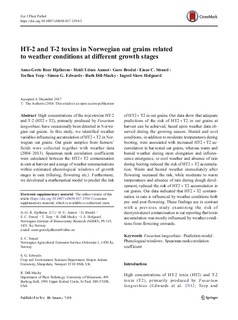| dc.contributor.author | Hjelkrem, Anne-Grete Roer | |
| dc.contributor.author | Aamot, Heidi Udnes | |
| dc.contributor.author | Brodal, Guro | |
| dc.contributor.author | Strand, Einar | |
| dc.contributor.author | Torp, Torfinn | |
| dc.contributor.author | Edwards, Simon G. | |
| dc.contributor.author | Dill-Macky, Ruth | |
| dc.contributor.author | Hofgaard, Ingerd Skow | |
| dc.date.accessioned | 2018-04-30T09:25:36Z | |
| dc.date.available | 2018-04-30T09:25:36Z | |
| dc.date.created | 2018-04-09T11:37:08Z | |
| dc.date.issued | 2018-01-08 | |
| dc.identifier.citation | Hjelkrem, A.-G. R., Aamot, H. U., Brodal, G., Strand, E. C., Torp, T., Edwards, S. G., … Hofgaard, I. S. (2018). HT-2 and T-2 toxins in Norwegian oat grains related to weather conditions at different growth stages. European Journal of Plant Pathology, 151(2), 501–514. | nb_NO |
| dc.identifier.issn | 0929-1873 | |
| dc.identifier.uri | http://hdl.handle.net/11250/2496499 | |
| dc.description.abstract | High concentrations of the mycotoxins HT-2 and T-2 (HT2 + T2), primarily produced by Fusarium langsethiae, have occasionally been detected in Norwegian oat grains. In this study, we identified weather variables influencing accumulation of HT2 + T2 in Norwegian oat grains. Oat grain samples from farmers’ fields were collected together with weather data (2004–2013). Spearman rank correlation coefficients were calculated between the HT2 + T2 contamination in oats at harvest and a range of weather summarisations within estimated phenological windows of growth stages in oats (tillering, flowering etc.). Furthermore, we developed a mathematical model to predict the risk of HT2 + T2 in oat grains. Our data show that adequate predictions of the risk of HT2 + T2 in oat grains at harvest can be achieved, based upon weather data observed during the growing season. Humid and cool conditions, in addition to moderate temperatures during booting, were associated with increased HT2 + T2 accumulation in harvested oat grains, whereas warm and humid weather during stem elongation and inflorescence emergence, or cool weather and absence of rain during booting reduced the risk of HT2 + T2 accumulation. Warm and humid weather immediately after flowering increased the risk, while moderate to warm temperatures and absence of rain during dough development, reduced the risk of HT2 + T2 accumulation in oat grains. Our data indicated that HT2 + T2 contamination in oats is influenced by weather conditions both pre- and post-flowering. These findings are in contrast with a previous study examining the risk of deoxynivalenol contamination in oat reporting that toxin accumulation was mostly influenced by weather conditions from flowering onwards. | nb_NO |
| dc.language.iso | eng | nb_NO |
| dc.publisher | Springer Netherlands | nb_NO |
| dc.rights | Navngivelse 4.0 Internasjonal | * |
| dc.rights.uri | http://creativecommons.org/licenses/by/4.0/deed.no | * |
| dc.subject | Fusarium langsethiae | nb_NO |
| dc.subject | Prediction model | nb_NO |
| dc.subject | Phenological windows | nb_NO |
| dc.subject | Spearman rank correlation coefficient | nb_NO |
| dc.title | HT-2 and T-2 toxins in Norwegian oat grains related to weather conditions at different growth stages | nb_NO |
| dc.type | Journal article | nb_NO |
| dc.type | Peer reviewed | nb_NO |
| dc.description.version | publishedVersion | nb_NO |
| dc.rights.holder | © The Author(s) 2018 | nb_NO |
| dc.source.pagenumber | 501-514 | nb_NO |
| dc.source.volume | 151 | nb_NO |
| dc.source.journal | European journal of plant pathology | nb_NO |
| dc.source.issue | 2 | nb_NO |
| dc.identifier.doi | 10.1007/s10658-017-1394-3 | |
| dc.identifier.cristin | 1578313 | |
| dc.relation.project | Norges forskningsråd: 173277 | nb_NO |
| dc.relation.project | Norges forskningsråd: 199412 | nb_NO |
| cristin.ispublished | true | |
| cristin.fulltext | original | |
| cristin.qualitycode | 1 | |

